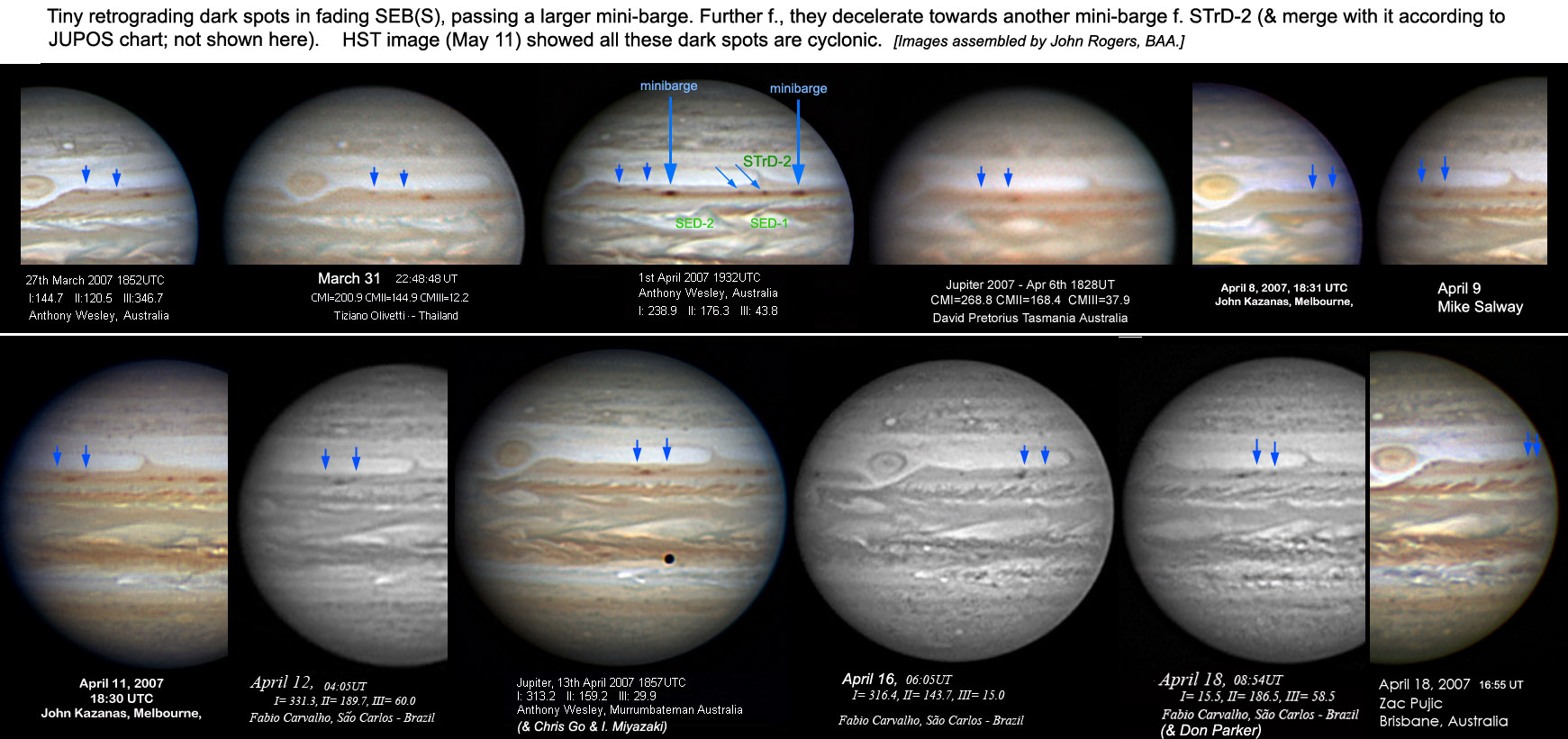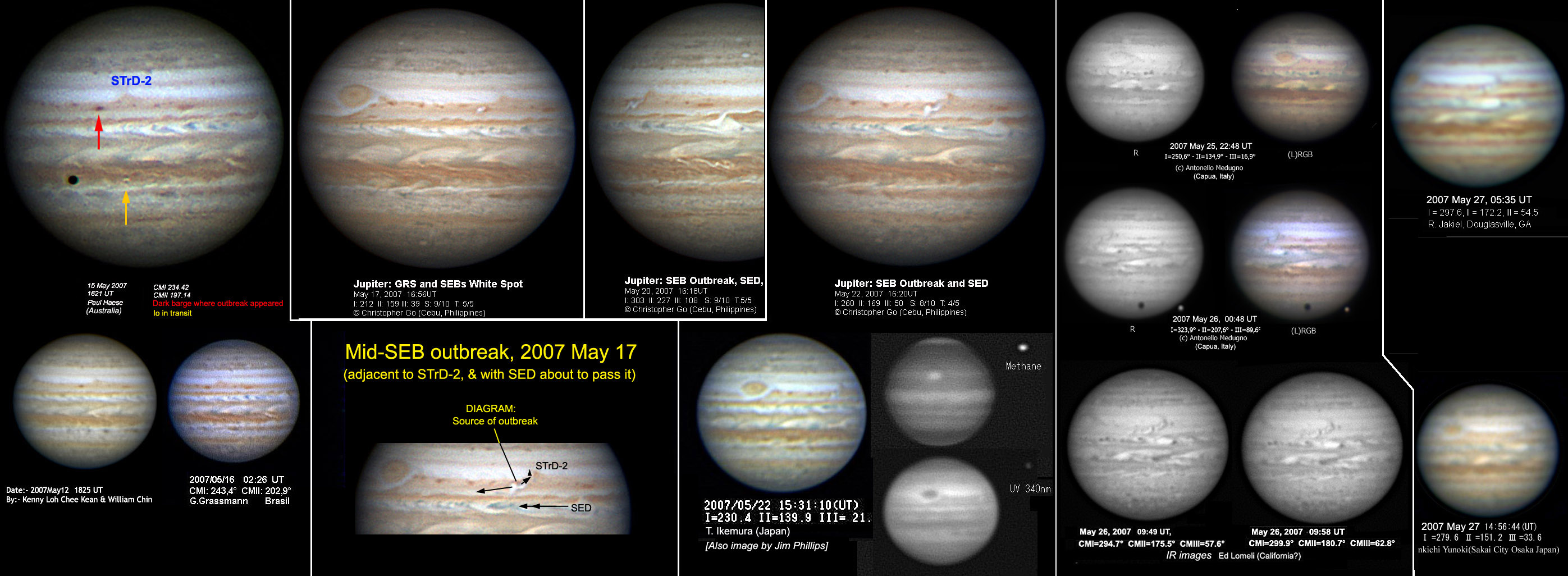| Dynamics in the fading SEB by John H.Rogers | Goto Japanese 日本語はこちら |
(1) The mini-barges and S. Tropical Disturbances.
The JUPOS team (Hans-Joerg Mettig, Michel Jacquesson, Gianluigi Adamoli,
Marco Vedovato) have recently posted their latest set of drift charts. The
attached chart [-16-26_combined.gif] is a combination of several of these
showing the small dark spots ('mini-barges') at 16-18 deg.S in the fading
SEB(S), along with the tracks of the two S. Tropical Disturbances.
The STrD's have both been prograding in L2, and STrD-1 has been steadily
expanding in longitude: both of these are typical properties of STrD's. (The
f. end of STrD-1 is extremely faint, but is still visible on May 28.) Both
STrD's have been fading along with the SEB(S), as expected.
The tiny dark spots in SEB(S) f. the GRS have been retrograding at DL2 ~ +50
deg/month, from March to May. The HST image on May 11 showed that these are
tiny cyclonic spots, and they are further north than the usual peak of the
retrograding SEBs jet stream, so they probably do not represent the full
speed of the jet. The JUPOS chart suggests that they passed a larger
cyclonic mini-barge at ~16 deg.S, L2 ~ 170, and this is confirmed by the
attached set of images [Set-f-GRS_Apr0-18_retrospots.jpg]. They did not
merge, although there was some interaction; in fact they may have undergone
a westward acceleration, which might be confirmed by making
higher-resolution JUPOS charts.
Further f., the chart shows that these spots decelerate as they approach a
larger mini-barge at L2 ~ 220, and apparently they do merge with it. We
don't have good images showing a merger, but the HST image on May 11 was
taken during one. The deceleration in some cases happened as the spots
passed STrD-2, consistent with the STrD modulating the SEBs jet, but not in
every case. (They are not deflected southward by the STrD.)
Another mini-barge, passing STrD-1, reversed its drift when alongside the f.
end of the STrD, so it now appears to be trapped within the longitudes of
the STrD.


(2) The mid-SEB white spot outbreak.
On May 17, Chris Go discovered as new white spot outbreak in the SEB,
starting within the mini-barge at L2=180 (just as a mid-SEB outbreak imaged
by Voyager in 1979 started precisely in the centre of a mini-barge). This
was surprising as such turbulent activity ceased last autumn, and was not
expected again before the whole cycle of SEB fading is complete. There must
be two opposite tendencies acting in the SEB. Locally, there is a tendency
for turbulent storms to erupt f. the GRS; but globally, there is a tendency
for the whole SEB to become stabilised with thick cloud cover. We are still
waiting to see whether this white spot outbreak will lead to a premature SEB
Revival, or will fizzle out allowing the SEB fading to continue.
Unfortunately, southern hemisphere observers have not been able to take
images in the last week, but some images from the northern hemisphere help
to track the outbreak. Thanks especially to the ALPO-Japan, for posting
some images. The outbreak has continued to develop, with a bright rift
extending Np., and dark material extending Sf. into STrD-2 (reversing its
recent fading) ? as expected from the currents in this area. Also a small
dark spot has appeared which may be retrograding past STrD-2. But the
outbreak is still not conspicuous in images of moderate resolution, 10 days
after it started, so it is still possible that it will die away.
The SED was passing it around May 27. The SED is marked by a brilliant great
white spot (dazzling in Rich Jakiel's image of May 27). This is SED-2, which
has gradually taken over from SED-1 (~30 deg. f. it) as the main complex.
 John H. Rogers,Ph.D.
Jupiter Section Director,
[British Astronomical Association.]
John H. Rogers,Ph.D.
Jupiter Section Director,
[British Astronomical Association.]Japanese 日本語(訳 伊賀 )
2007年の木星:中間レポート
淡化しているSEBのダイナミクス
(1)小バージと南熱帯撹乱最近、JUPOSチーム(Hans-Joerg Mettig, Michel Jacquesson, Gianluigi Adamoli, Marco Vedovato)が最新のドリフトチャートを公開した。添付したチャート[-16-26_combined.gif]は、2つの南熱帯撹乱(STrD)を追跡するとともに、淡化しているSEB(S)の南緯16‐18度にある小さな暗斑(小バージ)を示す組合せである。
南熱帯撹乱は両方とも体系2に対して前進していて、STrD-1は着実に経度方向に拡張している。これらの両方とも南熱帯撹乱の典型的な性質を持っている。(STrD-1の後端は非常に淡くなっているが、5月28日にはなおも見えている。)両方の南熱帯撹乱は、予想したように、SEB(S)とともに淡化している。
大赤斑の後方のSEB(S)にある小さな暗斑は、体系2に対するドリフト(DL2)が約+50度/月で後退している。5月11日のハッブル宇宙望遠鏡(HST)の画像では、小さな低気圧性の斑点があり、後退するSEBsジェット気流の通常のピークよりもかなり北にあり、そのためおそらくジェット気流の最大速度を示していない。JUPOSのチャートから、これらの暗斑は体系2=約170度、南緯約16度で大きめの低気圧性の小バージを通過していることが分かり、このことは添付した画像[Set-f-GRS_Apr0-18_retrospots.jpg]によって確認できる。これらはマージはしていないが、いくつかの相互作用があった。より高分解能のJUPOSチャートを作成することによって確認できるかもしれないが、実際に西向きの加速を受けているかもしれない。
さらに、チャートの後方には、体系2=約220度の大きめの小バージに接近するにつれて、これらの暗斑が減速していることを示していて、どうやらこれらはマージをしたらしい。マージを示す良い画像がないが、5月11日のHSTの画像はこの期間中に撮影された。暗斑がSTrD-2を通過する際に起こったまれな場合での減速は、SEBsのジェット気流を調整している南熱帯と調和しているが、これは全ての場合ではない。(これらの斑点は南熱帯によって南方にそれてはいない。)
STrD-1を通過するもう1つの小バージが、STrDの後端部に並んでいるとき、そのドリフトを反転させ、そして今はSTrDの経度の中に捕らえられたように見える。


(2)SEB中央の白斑突出現象
5月17日に、Chris Goが、体系2=180度の小バージの中で発生した、SEBの新しい白斑の突出(outbreak)を発見した(1979年にボイジャーによって撮影されたmid-SEB outbreakが、ちょうど小バージの中央で発生したのと同様である)。これは昨年の秋に擾乱活動が終わったのと同じぐらいの驚きであり、SEB淡化の全体のサイクルが完了する前に再び見られるとは予想していなかった。これらはSEBで活動する2つの反対の傾向であるべきである。局所的には大赤斑の後方に擾乱が噴出するという傾向があるが、全体的には厚い雲が覆うことでSEB全体が安定化するという傾向がある。この白斑の出現が、早すぎるSEB復活を導くものであるか、あるいはSEBの淡化を継続するように立ち消えになるのか、まだ待っている状態である。
あいにく、南半球の観測者は先週撮影することができなかったが、北半球からのいくつかの画像がoutbreakを追跡するのに役立った。画像を公開しているALPO-Japanに特に感謝する。outbreakは発達を続けていて、この領域の気流から予想されたように、1個の明るいリフトが北東(Np.)に拡がり、1個の暗い物質がSTrD-2内の南西(Sf.)に拡がっている(その最近の淡化を反転させている)。また、1個の小さな暗斑がSTrD-2を通り越して後退しているように思われる。しかしながら、outbreakは中程度の分解能では目立たなくなっていて、活動が始まって10日が経ち、なおも沈静化する可能性もある。
SEDが5月27日ごろにSEB白斑を通過した。SEDは輝く巨大な白斑として印を付けている(5月27日のRich Jakielの画像でまぶしい)。これがSED-2であり、SED-1(SED-2の後方約30度)から次第にメイン複合体として引き継いでいる。

John Rogers
2007 May 29
ALPO-Japan Latest
Jupiter Section